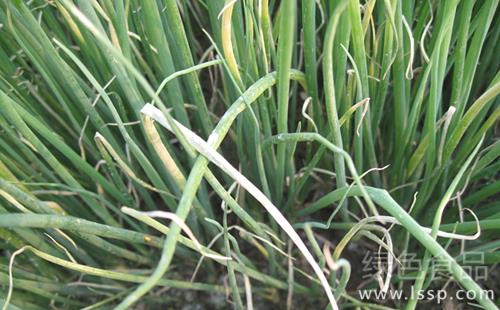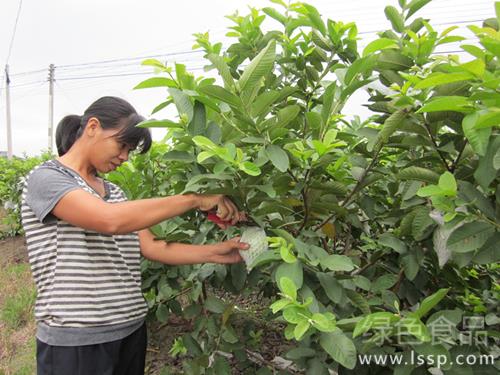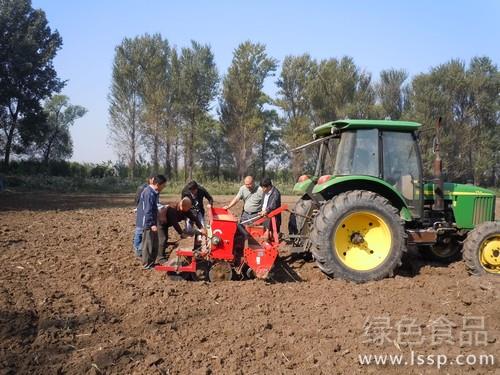Prevention and control of spring onion blight in autumn
Chives are prone to outbreak of epidemic shallot blight in case of high temperature and humidity. The original green chives became macular within 3 days, and then whitened, the onion leaves wilted, and even rotted, causing serious losses.

Spring onion blight
Spring onion blight harms spring onion leaves and pedicels. In the initial stage of onion leaves infection, evergreen and white spots are not obvious, and then expand into gray spots, spread longitudinally along the onion leaves, and become long white spots with a width exceeding half of the circumference of onion tubes or even larger; resulting in weight and withering of onion leaves; when it is overcast and rainy, the disease is white cotton hairy mold; when the weather is dry, the whiteness disappears. Tearing open the diseased leaves, there are still cotton-like white mycelia on the inside of the onion tube leaves.
The disease is caused by a fungus called Phytophthora tobacco. it is a highly pathogenic malignant infectious disease. the pathogen overwinters with spores or mycelia in the remnants of chives. In warm winter, bacteria can be infected year-round, onion species can also carry bacteria, and bacteria spores can be spread by wind, rain and airflow. After spore germination, germ tubes are formed, which penetrate the epidermis of onion leaves and directly invade the host. Under high temperature and humidity, shallot occurs quickly, produces spores, spreads rapidly and expands the damage. 25mil 32 ℃ is the most suitable for the disease. High temperature and humidity, continuous rain, the disease is easy to epidemic; high planting density, low-lying field water are conducive to the disease; the application of too much chemical fertilizer, heavy nitrogen fertilizer, chives weak, the disease is more serious.
Prevention and control of spring onion blight. First of all, good drainage of planting land, high border and deep ditch preparation, Rain Water timely drainage to reduce field humidity; thorough removal of diseased and residual plants of chives in the field; rotation with non-onion and garlic vegetables; reasonable fertilization, increase phosphorus and potassium fertilizer, and avoid partial application of nitrogen fertilizer. The application of plant ash is also beneficial to improve disease resistance. Once the epidemic situation is found, we should lose no time to prevent and cure it. The division sprays the following chemicals: Frost (60% enoylmorpholine manganese zinc wettable powder) 800ml 1000 times, Tianke manganese zinc (60% wettable powder) 700ml 800 times, Shuanglu Sujing (72% wettable powder) 1000ml 1200 times, Carmatone (64% wettable powder) 700ml 800 times, Ruidou mold (58% wettable powder) 500ml 600 times, preferably once every 7 days, 23 times in a row. In addition, Baikoning (40% suspension agent), ethylphosphine aluminum manganese zinc (70% wettable powder), Jiadanning and other agents have good control effects on shallot blight.
- Prev

Perennial flowering and fruiting, good benefit and autumn management of pearl guava
Perennial flowering and fruiting, good benefit and autumn management of pearl guava
- Next

Control Diseases and insect pests, improve the quality of Autumn sowing and set up High-yield frame to win High yield of Wheat
Control Diseases and insect pests, improve the quality of Autumn sowing and set up High-yield frame to win High yield of Wheat
Related
- Fuxing push coffee new agricultural production and marketing class: lack of small-scale processing plants
- Jujube rice field leisure farm deep ploughing Yilan for five years to create a space for organic food and play
- Nongyu Farm-A trial of organic papaya for brave women with advanced technology
- Four points for attention in the prevention and control of diseases and insect pests of edible fungi
- How to add nutrient solution to Edible Fungi
- Is there any good way to control edible fungus mites?
- Open Inoculation Technology of Edible Fungi
- Is there any clever way to use fertilizer for edible fungus in winter?
- What agents are used to kill the pathogens of edible fungi in the mushroom shed?
- Rapid drying of Edible Fungi

